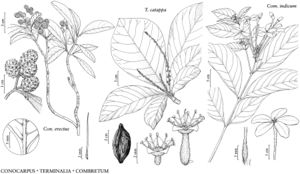Difference between revisions of "Combretum indicum"
Useful Pl. Dominica, 277. 1998.
imported>Volume Importer |
imported>Volume Importer |
||
| Line 56: | Line 56: | ||
|publication year=1998 | |publication year=1998 | ||
|special status= | |special status= | ||
| − | |source xml=https://xjsachs2@bitbucket.org/aafc-mbb/fna-data-curation.git/src/ | + | |source xml=https://xjsachs2@bitbucket.org/aafc-mbb/fna-data-curation.git/src/e39f0e846f172941159b2045254d62d10d9823f6/coarse_grained_fna_xml/V10/V10_683.xml |
|genus=Combretum | |genus=Combretum | ||
|species=Combretum indicum | |species=Combretum indicum | ||
Latest revision as of 10:33, 9 May 2022
Shrubs or lianas climbing, to 6 m. Leaves: petiole 5–20 mm; blade elliptic to oblong-elliptic to slightly obovate, 4–18.5 × 1.5–9 cm, base obtuse to slightly cordate, surfaces glabrate to densely pubescent, hairs combretaceous, and also scattered, inconspicuous, short-stalked, gland-tipped. Spikes 1.3–6[–12.5] cm. Flowers: sepals 1–3 mm; stamens 4–7.5 mm; style 10–20 mm (not including portion adnate to hypanthium). Drupes red, 25–40 × 7.5–14 mm, glabrous or sparsely glandular-pubescent. 2n = 22, 24, 26.
Phenology: Flowering spring–summer.
Habitat: Disturbed habitats.
Elevation: 0–20 m.
Distribution
Introduced; Fla., Asia (India to New Guinea), introduced also widely in Neotropics.
Discussion
Combretum indicum has been found in Broward, Highlands, and Miami-Dade counties.
Combretum indicum is cultivated in warm regions for its beautiful and fragrant flowers, which have petals that are white when the flowers open and change to pink and then deep red as the day progresses. This species (and relatives) often have been placed in the genus Quisqualis, a name derived from the Latin “quis” (who?) and “qualis” (what?), alluding to the initial uncertain taxonomic placement of the genus, or possibly in astonishment at its variable habit or the distinctive color change. The approximately 17 species of the Quisqualis clade are closely related to species of Combretum subg. Cacoucia (Aublet) Exell & Stace, which have similar gland-tipped hairs (C. A. Stace 2007, 2010), and recognition of this group of species at the generic level would render Combretum non-monophyletic (O. Maurin et al. 2010).
Selected References
None.
